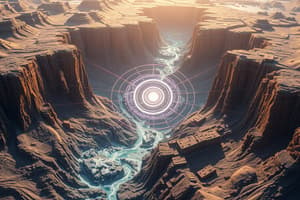Podcast
Questions and Answers
What type of seismic wave is characterized by moving both up and down and side-to-side, typically felt as the second wave during an earthquake?
What type of seismic wave is characterized by moving both up and down and side-to-side, typically felt as the second wave during an earthquake?
Love waves
Describe the method seismologists use to pinpoint the location of an earthquake's epicenter.
Describe the method seismologists use to pinpoint the location of an earthquake's epicenter.
Triangulation Method
What geological evidence supports the theory that continents were once joined together in a supercontinent?
What geological evidence supports the theory that continents were once joined together in a supercontinent?
Fossils and rocks record
What physical feature is formed when two continental plates collide and are pushed upward?
What physical feature is formed when two continental plates collide and are pushed upward?
What is the relationship between the height of waves on a seismogram and the distance of an earthquake from the recording station?
What is the relationship between the height of waves on a seismogram and the distance of an earthquake from the recording station?
Explain the concept of Pangaea and its significance in the study of continental drift.
Explain the concept of Pangaea and its significance in the study of continental drift.
Describe the interaction between the geosphere and the atmosphere during a volcanic eruption.
Describe the interaction between the geosphere and the atmosphere during a volcanic eruption.
What is the elastic rebound theory, and how does it relate to the occurrence of earthquakes?
What is the elastic rebound theory, and how does it relate to the occurrence of earthquakes?
Discuss the processes leading to the formation of tsunamis, and how they differ from regular ocean waves.
Discuss the processes leading to the formation of tsunamis, and how they differ from regular ocean waves.
Identify the primary geological features associated with the Pacific Belt and its significance in seismic activity.
Identify the primary geological features associated with the Pacific Belt and its significance in seismic activity.
Flashcards are hidden until you start studying
Study Notes
Continental Drift and Plate Tectonics
- Alfred Wegener proposed the Continental Drift Theory, suggesting the continents were once a single supercontinent called Pangaea.
- Pangaea existed approximately 200 million years ago.
- The Earth's age is estimated at 4.6 billion years based on rock and fossil records.
Earthquake Dynamics
- When volcanic eruptions release ash and gases, the geosphere and atmosphere interact.
- Earthquakes occur due to faulting (crust cracking) and folding (bending of the crust).
- The epicenter is the point on the Earth's surface directly above the earthquake's focus.
- Seismographs record ground movements caused by seismic waves, showing that higher waves indicate proximity to the earthquake.
Tsunami Formation
- Tsunamis result from underwater earthquakes or volcanic eruptions, creating large waves that can devastate coastal areas.
Seismology and Epicenter Location
- Epicenters are identified using the Triangulation Method through data from at least three seismological stations.
- A seismic wave that travels the fastest is called P waves, which push and pull as they move.
Plate Boundaries
- Divergent boundaries occur when plates move away from each other, often leading to volcanic activity.
- Convergent boundaries involve plates moving towards each other, which can create features such as trenches.
- Transform boundaries are locations where plates slide past one another, responsible for structures like the San Andreas Fault.
Volcanoes
- When magma surfaces, it is called lava.
- The three main types of volcanoes are cinder-cone, shield, and composite.
- A caldera is a large depression formed by volcanic eruptions.
Earth's Structure
- The Earth's layers consist of the inner core, outer core (liquid iron and nickel), mantle, and crust (the thinnest layer).
- The inner core is the hottest part of the Earth and is solid due to immense pressure.
- Endogenic processes (internal forces) and exogenic processes (external forces) shape the Earth's surface.
Heat Transfer in Earth
- Heat travels through the Earth's layers primarily via convection currents in the asthenosphere, with radiation present in the mantle.
Historical Evidence of Plate Movement
- Fossil and rock records provide clues that continents were once contiguous, supporting the theory of continental drift.
- South America and Africa exhibit noticeable fit, suggesting they were once connected.
Miscellaneous
- Subduction occurs when denser tectonic plates sink into the mantle, often leading to volcanic island arcs.
- Most earthquakes (around 80%) occur in the Pacific Belt, a zone characterized by high seismic activity.
Studying That Suits You
Use AI to generate personalized quizzes and flashcards to suit your learning preferences.




